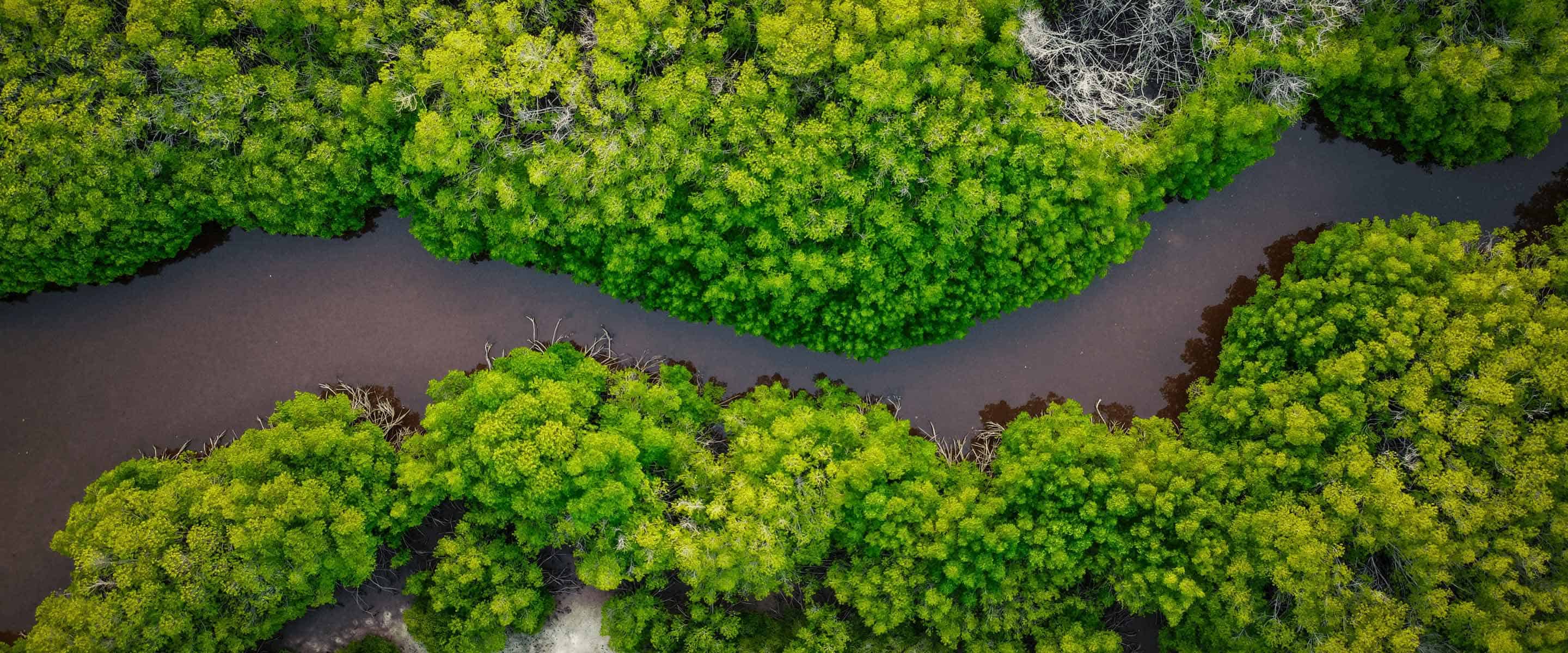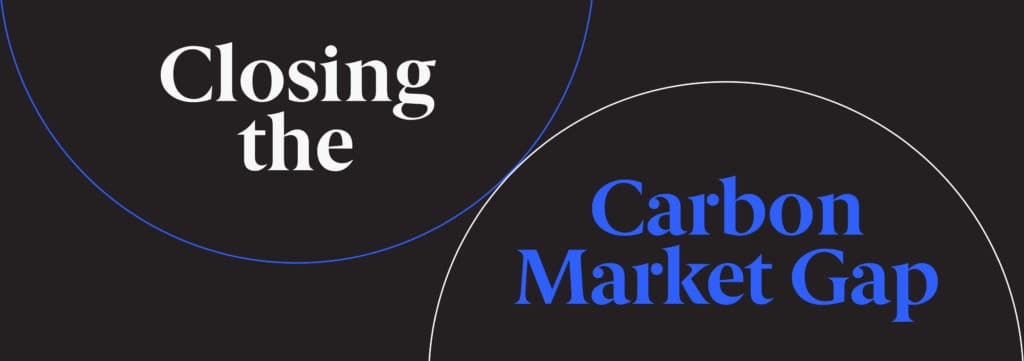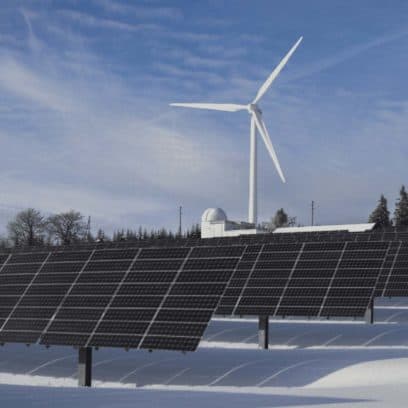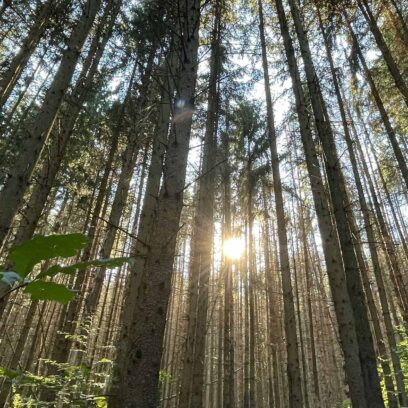What is the Carbon Market? Podcast with Nicole Sullivan


Closing the Carbon Market Gap
According to Bank of America, carbon offset supply may need to grow as much as 50x by 2050 to achieve net-zero emissions. Watch the replay as three experts discuss efforts to close this gap and the challenges in developing projects and issuing credits at scale.
“Low-carbon, high energy stories from the people solving the energy challenges of modern life.”
Last month our very own Nicole Sullivan, former Director of Climate Services at CarbonBetter, joined Joe Batir of the Energy Transition Solutions podcast for an hour-long conversation about the carbon markets, taking a deep dive into how companies can leverage carbon offsets to meet their sustainability goals and ways that CarbonBetter helps clients navigate complex climate decisions with confidence. Joe’s podcast is part of the Oil and Gas Network (OGGN), and he is a geothermal engineer by trade. On his podcast, he explores strategies and innovations powering a new future for global energy.
Listen to the Interview
Interview Highlights

[00:43] Joe: Hello, and welcome to the Energy Transition Solutions podcast, brought to you by AWS energy. I’m your host, Joe Batir. This is the show where we bring you low-carbon, high-energy stories from the people solving the energy challenges of modern life. I’m here today with Nicole Sullivan, Director of Climate Services at CarbonBetter. CarbonBetter, as the name suggests, is a privately held firm focusing on clean energy and carbon offset consulting.
Recently, we had a guest on the show talking about the carbon market, which made me well aware of just how much I don’t actually know about the carbon market.
So I’m glad that I met Nicole and have her as a guest today on the show, where she is going to help us take a deep dive into what exactly this carbon market is and how a company like CarbonBetter is also making this possible and helping the carbon market. So enough rambling for me. Let’s get into it.
Nicole, thank you for joining me on the show today. If you would please share with me and the audience your background and a quick introduction to CarbonBetter.

[1:49] Nicole: Sure. So I’m an environmental engineer by trade and I’ve spent more than a decade working in sustainability and environmental consulting across a whole range of industry sectors, including oil and gas, petrochemicals and manufacturing. In my day-to-day role at CarbonBetter, I support clients at every step of their sustainability journey, from quantifying and disclosing their environmental impacts, including carbon, to developing their sustainability strategy and ultimately reducing their emissions both directly and through participating in the voluntary carbon market.
We at CarbonBetter also help develop and market carbon credit projects. And we really believe that what’s good for the planet is good for business. So we’re here to help our clients every step of the way whether they’re just getting started or actively working towards reaching net zero.
[02:50] Joe: Very good. Thank you for your introduction. And of course, this podcast being the energy transition solutions podcast is all about the energy transition decarbonization and seeing the technology getting us to that low carbon future, sounds like that is really kind of in a sense where carbon better is helping companies along their decarbonization and sustainability journey. One major thing here, an unspoken assumption, is to reach this low-carbon future, there’s going to be some type of financial incentive to decarbonize. And that brings us to this idea of the carbon market. I don’t think I’ve actually asked any guest what exactly is the carbon market.
Nicole: So in answering your question, I’m going to focus on the voluntary carbon market, which allows carbon emitters (anyone that is generating carbon emissions or greenhouse gas emissions) to offset their unavoidable emissions by purchasing carbon credits from carbon offset projects that are targeted at removing or reducing carbon from the atmosphere. So the market itself is actually a little bit nebulous. There are actual marketplaces out there where you can go and buy carbon credits directly, and there are emerging exchanges like the CBL. But, there’s actually really not a one-stop shop for buying carbon credits in the voluntary carbon market. Many transactions are actually done over the counter through spot purchases.
While carbon credits and participation in the voluntary carbon market is a really important tool, we also encourage folks to reduce whatever emissions they can.”
NiCOLE SULLIVAN, former Director of Climate Services
We are seeing more carbon projects come to market but we're also seeing more participants purchasing carbon offsets. It's very much an evolving market. One concept that I also want to introduce quickly is that while carbon credits and participation in the voluntary carbon market is a really important tool, we also encourage folks to reduce whatever emissions they can. So if you're making a product, it's really hard to produce that product with zero carbon emission. Even if you do energy efficiency projects, you're still going to have some amount of carbon emissions that you can't abate. So carbon credits—and participation in the voluntary carbon market—is a really important tool to bridge that gap.
Understanding the Jargon
[07:47] Joe: Okay. That's helpful. And now we've talked about carbon credits and you've also said reduction and carbon offsets. I guess what's the difference in all of these different terms?
Nicole: There's a lot of jargon in the space and a lot of terms that probably get used more interchangeably than they should. The core concept of carbon offsetting stems from being able to balance out your carbon emissions through carbon offset projects. Carbon offset projects are projects that reduce or sequester or capture carbon, and those projects can generate carbon credits. So, to offset your emissions you can purchase carbon credits and then retire those credits to ultimately balance out your carbon emissions. So when you retire a carbon credit, you have offset your emissions with that credit.
In the voluntary space, carbon credits get issued by carbon registries when you register a carbon offset project. So each of these carbon credits represents one metric ton of carbon dioxide, and it's certified through a registry and has a serial number or a tangible representation on that registry. There's a number of different carbon registries out there. Some examples of those are the Verra Carbon Standard Climate Action Reserve, the Gold Standard, and these registries have logs of all the carbon credits that have been registered through their protocols.





Some of these registries even use their own terms. So for example, on the Verra Carbon Standard, a carbon credit is actually referred to as a verified carbon unit or VCU. You'll also hear the term carbon credit in the regulatory space, in terms of cap and trade programs, where carbon credits act as allowances. So if you have a mandatory cap on your carbon emissions where you're only allowed to emit up to X amount of carbon, and then say you emit less than that, you could get a generated credit for being under your cap.
Types of Carbon Offset Projects
[12:34] Joe: Can you go through some of these different carbon offset projects that can ultimately become a carbon credit?
Nicole: There are actually a significant number of—the industry term is technologies, or we also use the word interventions. These activities can reduce, avoid, or sequester carbon. There are a few buckets of carbon offset project types. first, there are nature-based projects. Those would include things like improved forest management and reforestation as well as agroforestry. Agroforestry is one that I'm really passionate about. We're actually working with a project in Ghana—OKO Forests—to help them develop credits from an agroforestry project, which is where in addition to planting trees, you're also planting cash crops and food sources. So in addition to sequestering carbon, there's this co-benefit of providing food security as well as income streams for local farmers. Currently, there are also things like mangroves, and blue carbon projects that are evolving.
There are also non-nature-based projects. So things like renewable energy projects, wind, hydroelectric power, even solar projects, and then industrial projects such as nitrogen oxide abatement. There's really a whole spectrum of ways that you can sequester and reduce carbon and then there are different protocols for developing the carbon credit for each of these different technology types.
For any of these project types, a project developer, or someone that is implementing this project, would work to certify the project with a given registry and follow that registry's protocol. There are improved forest management protocols out there on both the American Carbon Registry, as well as the Vera Carbon Standard and others. But those protocols look a little different depending on the registry. But each of those protocols has steps for quantifying the carbon and ultimately measuring it and proving how many carbon credits should be issued. As you can imagine, this process actually really takes some significant effort and time. But ultimately, the level of rigor is actually super important. And the documentation that gets generated with the certification is also very important for the end user of the credit because it gives you that trust that what you're buying represents a metric ton of carbon.
Choosing a Registry
[15:57] Joe: Why would anybody choose one registry over another?
Nicole: There are a number of registries out there, and the list continues to grow. There are some bigger registries that have emerged in the space and have been in the space longer. Some of those I've mentioned along the way, such as Gold Standard, American Carbon Registry, Climate Action Reserve, and there's also Verra Carbon Standard, Plan Vivo and a number of others.
But in terms of choosing a registry, you want to look for something that is publishing records, that has a public ledger of their projects, of their retirements, and that is publishing the documentation associated with projects. There are some smaller one-off registries out there that you might not feel as comfortable transacting on because they're not making their data public.
But ultimately, a lot of it comes down to availability as well. Maybe you're looking specifically for a reforestation project in the United States to offset your emissions and you found some projects that are available on Climate Action Reserve, or maybe you want a project that is say in Africa. And there are obviously some registries that aren't global. So you might look to a global registry if you have a specific location in the world that you're looking for a project to purchase from.
[20:13] Joe: Yeah, I think that's one of those things that as we are looking at the growth of the carbon market, something that others will probably be thinking about. Now with retirement, we've talked about retirement quite a bit here, and I'm not sure I fully understand what this "retirement" is. And it sounds like it is a definitive moment in time, but is it something that you can prolong or like, I guess, can you explain the retirement process a little bit more?
Carbon Offset Retirement Explained
Nicole: Yeah, of course. Say I have quantified a business's emissions for the calendar year, 2021. They had a thousand metric tons of carbon that they emitted. And then I turn around and I purchased a thousand metric tons of carbon credits on their behalf. They don't actually cancel out their emissions, that thousand metric tons until they apply those carbon credits through retirement. So basically it's a carbon accounting mechanism where you've done your math, you've purchased your carbon credits, and then you retire those credits to cancel out your emissions. And so then you actually retire them.
And a retirement note will show up on the registry once you've processed that retirement. So you could say, "retired on behalf of X, Y, Z company," or if a company is purchasing offsets on behalf of their customers, the note might say, "on behalf of the customers of this business." But ultimately the act of retiring the credits is the step in the carbon accounting process where you have canceled out your emissions by retiring those carbon credits and officially applying them to those emissions.
"I would say that not all carbon credits are created equal because as you're evaluating carbon credits, you have to really think and look at the data. Did that carbon credit you bought, or you're looking to purchase, actually reduce or avoid a metric ton of carbon emissions?"
NiCOLE SULLIVAN, CARBONBETTER

Important Considerations for Carbon Offset Vintages
Understanding carbon offset vintages is important for choosing the right offsets.

Intro to Carbon Offset Registries
An overview of the role carbon offset registries play in the carbon market, and why they matter.
[22:22] Joe: Okay. Now, as we're talking, I'm getting more questions in my mind about actually generating carbon credits. I think the most relevant right now, as you're walking through this, my mind is immediately going to different types of oil to relate to different types of carbon credits. Kind of talking in terms everybody would know WTI versus Brent, the spot prices on those are often different. So those different crudes are priced differently. Is this the same with carbon credits as in, are all carbon credits equal or not?
Nicole: That's a great question. My answer is kind of two-fold because I would say that not all carbon credits are created equal because as you're evaluating carbon credits, you have to really think and look at the data. Did that carbon credit you bought, or you're looking to purchase, actually reduce or avoid a metric ton of carbon emissions? There are a number of factors in that. Like, how old is the credit? Have the protocols for that carbon credit changed? What type of project is it? Is there additionality? Did this action actually sequester carbon or avoid carbon versus is this something that would've happened even in the status quo? And so it can be hard to compare different carbon projects across so many different technologies ranging from renewable energy all the way to agroforestry.
And so with those differences in technology, you also see significant variability in the pricing of carbon credits. Typically, nature-based projects tend to drive a higher price point. Similarly, geography plays a factor in pricing. US-based projects can be more expensive sometimes than projects elsewhere in the globe. I just mentioned the age of the credit plays a role. We refer to that in the space as the vintage of the credit and that can impact costs. So typically an older vintage project might transact at a lower price point. And then there are things like the volume that you're purchasing. So if you're purchasing in high volume, you might be able to get things at a slightly different price point, than if you're looking to purchase a small volume of credits.
And then something I touched on very briefly earlier is the co-benefits of a project. What else is that project doing besides reducing your carbon emissions? Are there water benefits associated with the project or food security benefits? Are they helping meet other United Nations sustainable development goals (SDGs)? There are a number of factors that can really impact the price point and the variability in pricing. But because so many of these transactions are done on a spot basis or over the counter, pricing data can be really hard to come by and transparency on the price of transactions isn't always readily available. So in that regard, the voluntary carbon market can feel really opaque from a pricing perspective.
How a Carbon Offset is Created
[27:41] Joe: At what point in the process does it become a credit? I guess what I'm trying to say is I'm imagining that what you do is you go through the whole process, you make your tally book and you show proof that you've avoided carbon for the past year, say that's the one metric ton. And now you have that one carbon credit that you can go sell, whereas I'm also wondering is selling carbon credits in avenue to actually go and do one of these reforestation projects in which case you're actually selling the carbon credits before you actually do the carbon avoidance.
Nicole: You can do all the paperwork associated with the project and it becomes a credit once the registry approves your math essentially, and issues that credit. And then you turn around and sell and transact on that issued credit. We have seen some folks try to presale credits, perhaps with long-term off-take agreements. There is some risk associated with pre-selling credits in that way—what happens if the project fails or the credits don't get issued?
But as a buyer, there are definitely inherent risks to pre-buying a credit because the registry timelines are variable. And especially as there's more backlog of projects coming to market, it can take time for registries to issue those credits. And then there are cases where projects fail or don't get as many credits issued as they might have expected. So there are a number of considerations associated with that.
The Main Goal of the Carbon Market
[31:18] Joe: Oh, okay. That's very interesting. And this whole market is interesting to talk about. I think that we've been kind of in the weeds trying to understand the market. Now I want to take a step back. I think we understand the market is selling these quantities of carbon, in this case really avoided or reduced carbon from your perspective, I guess, what is the main goal of the carbon market?
Nicole: Sure. So I really see the goal as kind of two-fold. The voluntary carbon market creates ways for companies to offset their emissions, especially emissions that they cannot reduce themselves. It provides a pathway to mitigate those emissions when they cannot implement a project directly on their site. And this comes into play with companies that have set goals to reach net-zero, or even just goals to reduce their emissions. Carbon credits, which you shop for in the voluntary market, are a tool to be used. And I would argue that it's really currently impossible to be zero carbon or carbon-free directly. So they're a tool that's needed.
So the voluntary carbon market comes into play as a tool for companies to use. It also really creates a pathway to fund carbon reduction and sequestration projects. So by enabling these project developers to bring these projects to market and generate carbon credits. It creates funds that get generated from selling these credits and that can be utilized to keep these projects going and develop more projects. So the real goal of the voluntary carbon market is decarbonization and climate mitigation, but it serves two purposes in that regard.
I think another advantage is just creating pathways to develop more carbon reduction projects. The registries are constantly doing more work and bringing more protocols and technologies to life that are eligible for generating carbon credits. I think it's really creating an incentive to develop carbon offset projects, which I think is hugely valuable as we work to reduce emissions globally. I do think there's risk when you can ultimately become net-zero exclusively through carbon credits.
As a business, your goal, in my opinion, should be to reduce your emissions that you can first before then offsetting the rest. But there are no rules that say you can't just achieve net zero exclusively through carbon offsets. I think another challenge we'll see is that we've got a lot of companies making net-zero pledges, which is fantastic. We all want to see companies do better and strive to make progress. But there's only so much carbon available in the voluntary carbon market. And so we will need collaboration and we will need to find other ways to reduce emissions besides just exclusively purchasing carbon credits.
Buy Your Way to Net Zero?
[36:32] Joe: Yeah. That's a really interesting point that you make and something that I started to think about that essentially a larger corporation that has more disposable income, so to speak. They can then go and buy more carbon credits and essentially be able to buy their way to net zero. Whereas if you don't have that large disposable income and the extra profits to do so then you either have to find a way to reduce your carbon footprint or you will then not be able to reach net zero goals for your company. And in that way you are almost being penalized for not being able to buy your way to net zero.
Just a thought that's rolling through my mind as we're talking through this. Now I ask all of my guests when they think we'll reach net zero. And I think we've been talking about net zero here, but when we talk about it, it's very clear that there isn't really a good hard definition. Now you've been working in this space for quite some time now. So I want to know what is your definition of net zero?
[38:06] Nicole: Sure. To get to net zero, there's a lot of complicated math and assumptions in there. But ultimately it's really a super simple math equation where you take your carbon emissions or your carbon released into the atmosphere, and you subtract your carbon reductions and you get the numbers to balance out to zero. Ultimately net zero is your emissions minus your reductions equals zero. So your carbon emissions can include emissions directly from your business or from you as an individual, as well as indirect emissions from purchased energy or emissions all across your entire value chain, including your suppliers. I'm sure you're familiar with the concept of scopes one, two, and three.
And then carbon reductions can include directly reducing your emissions through, say, an energy efficiency project or the replacement of a piece of equipment or indirectly reducing your emissions by purchasing carbon credits from carbon offset projects globally. And also renewable energy certificates or RECs are also a tool. To get to net zero, we just need to get the numbers to balance out so that our emissions minus our reductions equal zero. But something worth noting is that the complexity of reaching net zero really varies greatly depending on the type of business or operation you have. So for an office building, reaching net zero might be pretty easy, but for a manufacturing company with a complicated supply chain, reaching net zero can be quite difficult.
What's Included in Net-Zero Math
[40:05] Joe: When we're talking about net zero and the scope one, two, and three emissions, help me understand, if everybody were to get to net zero on their scope one emissions, wouldn't that ultimately mean that everybody is net zero?
Nicole: I would really argue that your net zero equation should include your entire emissions footprint—scopes one, two, and three. But the challenge in this space is that you can kind of set your boundaries however you want because this is voluntary. You can set the boundaries of your emissions that you're essentially reaching net zero for. So it can be really hard to compare apples to apples when we talk about net zero. And so it's really important to have transparency in any claims that you're making and to provide math that supports your claims. So that it's clear to folks what the boundaries of your math were.
[41:35] Joe: That's really helpful to hear and understand. And this conversation is also helping me formulate these different ideas. And one of the questions that I had was that in this current energy economy with everybody claiming these net-zero goals, when we may not have a clear definition of what net zero means for any given company, given a quick tagline or a blast on social media. And I will volunteer that I proliferate this idea of needing to reach a net-zero society, but I'm wondering, is that the right goal that we should be targeting? Or is there something else that I should be asking all of my guests a different question than when will be net zero?
What's Excluded in Net-Zero Math
Nicole: Before I answer your question, can I take a moment to quickly talk about what is left out of a net-zero equation?
Joe: Yes, absolutely.
Nicole: In a net-zero approach, you are focused exclusively on carbon emissions. You don't look at air emissions besides carbon, such as hazardous air pollutants. You're not looking at water impacts such as consumption and discharge. And water is such an important one because it really is directly related to climate change and carbon impacts. You're not looking at waste impacts such as solid waste, plastic waste, hazardous waste. All of those things should be considered in a holistic environmental strategy, but I think it is critical for folks to know that a company can achieve net zero without considering any of its other environmental impacts. So that's going to play into my answer a little bit in terms of if net zero is the right goal.
And I would say net zero is an important goal and a great goal. But it shouldn't necessarily be the only goal. There are a lot of other opportunities to have an impact and something that I get concerned about with all of the pressure to reach net zero, is that an inability to get all the way to zero can hinder folks from getting started. So if we're just focusing on making this carbon math equation reach zero, it can take our eye off of the ultimate problem of really protecting our environment and doing whatever we can to mitigate the full spectrum of our environmental impacts. So beyond just focusing on getting the equation to reach zero, I really feel like we should focus on being accurate to the extent we can with our emissions and impactful with our reductions, even if we can't get to zero today.
I also just really think targets should be tailored to your operations and how your business or operation relates and interacts with the environment. I don't think we should be looking at carbon in a vacuum, even though we definitely should be looking at carbon and carbon is hugely important. We should also be looking at our other air emissions, our water, and our waste impacts, and do our best to also make strides there.
[45:18] Joe: That's a really great point and something that I was trying to figure out how to ask or trying to figure out what I was going to say, and this makes it helps me because I think about things like the east Texas Piney woods or switch grass or all of these very fast growing organic matters as being a way to sequester carbon for a period of time and to generate carbon offsets. But ultimately what you were talking about earlier with the co-benefits of agroreforestation. To me, that is a much better solution. And that is something that is more of a holistic solution, whereas if you're just looking at that carbon offset, you would want to put away as much carbon as fast as possible, but ultimately that could mean something that is detrimental in certain other areas that would end up producing a lower overall beneficial impact.
Nicole: Yeah. So I think ultimately we need to look at a number of solutions in tandem. I think we're at this point where it's an all-hands-on-deck situation and there's not going to be one end-all be-all solution to reaching net zero or decarbonizing. It's about having tough conversations, collaborating, and finding ways to reduce our environmental impacts in really meaningful ways.
How CarbonBetter Fits In
[47:08] Joe: Yes, absolutely. Well, I've really appreciated your candid answers and fielding these tough questions, because I know these have not been very nice softball, easy questions to discuss. And so thank you very much for your time. I really appreciate it. One thing that I am not fully aware of, is where exactly does a company like carbon better fit into this equation?
Nicole: So really we're here to help. We help companies at every stage of their sustainability journey. We ultimately want to help companies reduce their carbon footprints and participate in the carbon economy. But really, we want to help people take action today wherever they are. So if they haven't quantified an environmental baseline yet or quantified their environmental impacts to ultimately set reduction targets and then offset their emissions or implement water projects, we can help with all of that. We can help with that strategy and then we can ultimately help them reduce their emissions.
We really believe in choosing progress over perfection and taking action and this is a space that continues to evolve. We're here to help folks make it easier because as you've seen the carbon market is complicated. So we're here to navigate that for folks.
[48:43] Joe: Yes, it is quite complicated. So thank you for putting that in perspective and in helping us see how we can start moving forward. I really like the phrase progress instead of focusing on perfection. Now with that, I want to jump into the final questions. These are the questions I ask all of my guests, the first one being, what is a favorite book of yours that you would recommend?
Nicole: So I'm actually currently rereading A Sand County Almanac by Aldo Leopold and it is a personal favorite. The way he writes about nature is just so prolific. He is kind of one of the OG conservationists and an ecologist, and it just really makes you feel called to better care for our environment and conserve our resources. And the way he talks about certain bird species and plants, you feel like you're there and it's really neat.
[49:45] Joe: I like it. It is on my bedside table about midway through the stack of books that I need to read. So it is already on the list and a little bit further, because I have a copy of it.
Nicole: Perfect.
When Will We Be Net Zero?
[50:01] Joe: And the next question, when will we be net zero as a society?
Nicole: So despite my role and background, I don't actually have a good answer for this. Right now there's an increasing number of companies and countries setting net-zero targets. But not all of those folks have clear roadmaps for how they're going to get there. And I think technology is going to continue to evolve and the carbon market is going to continue to evolve. So scaling up technologies is going to be important. Bringing more supply to the carbon market is going to be important, taking action and finding ways to directly reduce emissions. All of these things will be important levers for reaching net zero, but I truly don't have a good answer for you. So I'm not even going to take a pass at it.
[50:54] Joe: That is okay. I like that nuanced approach. And that nuanced answer. I'm going to add one more and maybe I will switch this one in without net zero what would be a better goal to discuss maybe when or what does a sustainable society look like for you?
Nicole: That's a great question to me. I think a sustainable society is going to look like ultimately reducing our consumption. So when we look at environmental impacts more holistically and we include waste and water, as well as carbon and energy. I think we as individuals and then businesses as well, if we can find ways to ultimately reduce our consumption, participate more in our local economies, and in some ways go back to more traditional ways of doing things—ultimately that can be hugely impactful.
[51:56] Joe: I like that. So then the last question I have is actually now you get to ask me a question.
Nicole: Sure. So given the topic of your podcast and all the conversations that you've been having, what do you see right now as the biggest challenge or the biggest opportunity in the energy transition space?
[52:23] Joe: Yes, the biggest challenge by far, and I think we've highlighted it here today is just scaling up. We have a lot of carbon that needs to be sequestered. We have a lot of energy that needs to be produced in a low carbon way, and we need to kind of change very large systems like the current food system, the current energy, and maybe change out fuels for the current transportation system. So the biggest challenge is just finding a way to scale and scale at an exponential rate because we need to start making significant progress and we need to make it rather quickly. There is a talk that I was at, that if we want to hit net zero goals by 2050, there needs to be a significant advancement in technologies and significant adoption by 2030, and kind of these next 10 years is really going to show what trajectory we're on and kind of give us the odds on whether we are going to hit those goals.
So that is the biggest challenge I see, I think in that same light, there's so much opportunity. I see it almost every day. I get emails from the department of energy here in the US, and there are new funding opportunity announcements that are coming out every single day; whether it's solar, whether it's wind, whether it's geothermal, whether it's deep geothermal, there are always opportunities to seek funding to start building those solutions. And I think that I also see that coming from the private side of it with capital wanting to see solutions being implemented. So I think those are the challenges in scaling up. But the opportunity is that if you have a scientifically sound idea and maybe even not scientifically sound if you just have an idea that can be tested, people are willing to, if you find the right people, you can get funding to start testing that idea. And maybe you're the next unicorn that, for lack of a better term saves the world.
Nicole: Definitely.
[55:19] Joe: Well, Nicole, thank you for joining me on the show today, before we sign off. Is there anything else that you would like to say?
Nicole: Just that I really appreciate the opportunity to have this conversation. Sustainability and the carbon world can often feel more complicated than it should. And I think people are afraid to misstep on sustainability and have some challenging conversations. I really think having dialogue like this and getting folks engaged is so important. I really value the opportunity.
